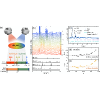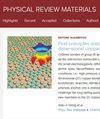Superconducting phase diagram in BixNi1–x thin films: The effects of Bi stoichiometry on superconductivity
IF 3.4
3区 材料科学
Q2 MATERIALS SCIENCE, MULTIDISCIPLINARY
引用次数: 0
Abstract
The Bi-Ni binary system has been of interest due to possible unconventional superconductivity aroused therein, such as time-reversal symmetry breaking in Bi/Ni bilayers or the coexistence of superconductivity and ferromagnetism in crystals. While Ni acts as a ferromagnetic element in such systems, the role of the strong spin-orbit coupling element Bi in superconductivity has remained unexplored. In this work, we systematically studied the effects of Bi stoichiometry on the superconductivity of thin films () fabricated via a composition-spread approach. The superconducting phase map of thin films exhibited a superconducting composition region attributable to the intermetallic phase with different amounts of excess Bi, revealed by synchrotron x-ray diffraction analysis. Interestingly, the mixed-phase region with and Bi showed unusual increases in the superconducting transition temperature and residual resistance ratio as more Bi impurities were included, with the maximum () observed at . A correlation analysis of structural, electrical, and magneto-transport characteristics across the composition variation revealed that the unusual superconducting “dome” is due to two competing roles of Bi: impurity scattering and carrier doping. We found that the carrier doping effect is dominant in the mild doping regime , while impurity scattering becomes more pronounced at larger Bi stoichiometry.

BixNi1-x 薄膜中的超导相图:铋的化学计量对超导性的影响
铋镍二元系统一直备受关注,因为其中可能产生非常规超导性,例如铋镍双层膜中的时间反转对称破缺或铋镍晶体中的超导性与铁磁性共存。虽然镍在此类体系中充当了铁磁元素,但强自旋轨道耦合元素 Bi 在超导中的作用仍未得到探索。在这项工作中,我们系统地研究了 Bi 的化学计量对通过成分分布法制造的 BixNi1-x 薄膜(x≈0.5-0.9)超导性的影响。通过同步辐射 X 射线衍射分析,BixNi1-x 薄膜的超导相图显示出一个超导成分区域,该区域可归因于过量 Bi 的金属间 Bi3Ni 相。有趣的是,Bi3Ni 和 Bi 的混合相区随着 Bi 杂质含量的增加,超导转变温度和残余电阻比也出现了不同寻常的增长,在 x≈0.79 时观察到了最大 Tc(=4.2K)。对整个成分变化过程中的结构、电学和磁传输特性进行的相关分析表明,不寻常的超导 "圆顶 "是由于铋的两种相互竞争的作用:杂质散射和载流子掺杂。我们发现,载流子掺杂效应在温和掺杂体系(0.74≤x≤0.79)中占主导地位,而杂质散射在较大的铋化学计量时变得更加明显。
本文章由计算机程序翻译,如有差异,请以英文原文为准。
求助全文
约1分钟内获得全文
求助全文
来源期刊

Physical Review Materials
Physics and Astronomy-Physics and Astronomy (miscellaneous)
CiteScore
5.80
自引率
5.90%
发文量
611
期刊介绍:
Physical Review Materials is a new broad-scope international journal for the multidisciplinary community engaged in research on materials. It is intended to fill a gap in the family of existing Physical Review journals that publish materials research. This field has grown rapidly in recent years and is increasingly being carried out in a way that transcends conventional subject boundaries. The journal was created to provide a common publication and reference source to the expanding community of physicists, materials scientists, chemists, engineers, and researchers in related disciplines that carry out high-quality original research in materials. It will share the same commitment to the high quality expected of all APS publications.
 求助内容:
求助内容: 应助结果提醒方式:
应助结果提醒方式:


